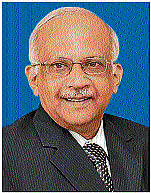
In the 57 years of existence, Manipal University has emerged as the leading higher education provider in India. Spread over 600 acres of green expanse, it is home to 20,000 students pursuing undergraduate and post graduate programs in diverse subjects. Interestingly, the University has a strong alumni network of over 72,000 members.
In fact, Manipal is a knowledge powerhouse and a brand name in higher education. Over five and half decades ago, one man, Dr Tonse Madhava Anantha Pai, had a vision which ensured that everything he did then, was consigned to posterity, making sure that generation after generation of students enjoy the fruits of his labour till eternity on this lateritic plateau.
In 1953, he set up Kasturba Medical College (KMC), the first private medical college in the voluntary sector. And, with that began the story of Manipal University. Then, in 1957 came the engineering college, the dental college, pharmacy college and so on and so forth. Initially, these institutes were affiliated to different universities.
Dr TMA Pai passed on the baton of leadership to his son, Dr Ramdas M Pai who is the present President and Chancellor of the University. In 1993, MAHE was accorded a deemed university status by the Union Ministry of HRD. Today, it has 20 constituent institutions comprising medical, dental, engineering, architecture, nursing, allied health, pharmacy, management, communication, hotel management, biotechnology, regenerative medicine etc.
Speaking to City Herald, Vinod Bhat, the Pro Vice Chancellor of Manipal University, shared some information on the contribution of Manipal university to higher education and internationalisation of higher education.He has been instrumental in establishing several linkages with universities abroad and for starting dual degree programmes and research collaborations. Excerpts:
When did the foreign students started coming to Manipal university?
The first batch (1953) itself had two foreign students. In 1960s, KMC started getting regular students from Malaysia. However, by 1970s, students from East Africa, South East Asia and North America started arriving at Manipal to take up medicine courses.
Perhaps, the word of mouth (from those who studied here), the quality of educaiton and 4 to 5 times less expensive courses (compared to West) are the reason for the rise in number of foreign students in Manipal.
In fact, now we have some students, whose parents too had studied here.
The number of foreign students in Manipal university?
Not less than 3,000, that includes nearly 2,000 foreign students and more than 1,000 NRIs.
Students from how many countries study in Manipal?
Manipal has students from 53 countries that includes North America (US, Canada, etc), East Africa (Kenya, Uganda, Zambia, etc), GCC countries (UAE, Oman, Qatar, Bahrain, Saudi Arabia, etc), Malaysia (there is a speical twinning programme for Malaysian universities), Sri Lanka, Mauritius, Seychelles, etc...
Any student exchange programmes?
More than 150 students from different parts of the world come to Manipal every year on an exchange programme under International Agency for Exchange of Students for Technological Experience (IAESTE). The same number of students visit forign countries too. Such students are provided with free boarding and meal coupons. Besides, a sum of Rs 5,000 is given as stipend per month. The courses range from 4 weeks to 16 weeks duration.
Any significant change / rise in number of foriegn students after the deemed university status?
There is a 15 per cent rise in number of international students after the deemed university status. At present, we have over 300 programmes in the university for undergraduate as well as postgraduate students.
Contribution of Manipal university to higher education?
Manipal university is the single largest foreign exchange earner in higher education in India in the last 10 years. Its remarkable, as Manipal is a very small place. Besides, its not well connected with metros too. Manipal has shown that education thrives in the absence of metropolitan status too.
About campuses outside India?
Manipal University has branch campuses in Malaysia, Dubai and Antigua in the Caribbean Island. MU also has an international academic collaboration for twinning programmes in engineering with universities in the US, UK, Australia and other countries.
Dubai campus has all courses except medicine. We are exploring the possibility within the next 2 years.
Any special activities for foreign students?
As there are nearly 1,000 Malaysian students, they regularly organise special programmes. Besides, students from all countries celebrate their national days. Showing Nigeria and Oman flags in his chamber, he said the students had recently celebrated their national day when they presented thier national flag to him.